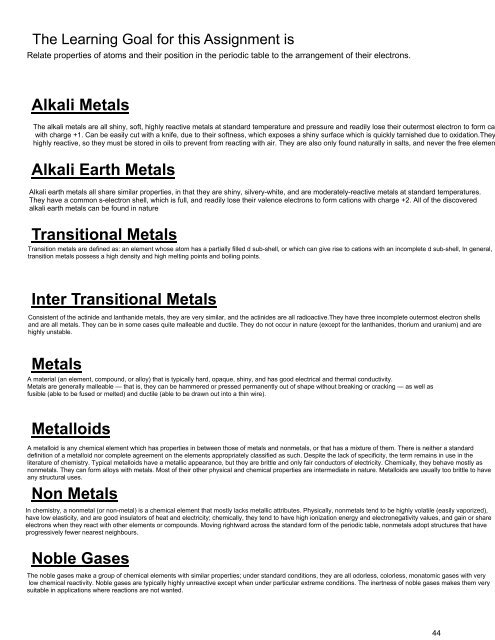FINISHED_Final_Notebook_Jones
You also want an ePaper? Increase the reach of your titles
YUMPU automatically turns print PDFs into web optimized ePapers that Google loves.
The Learning Goal for this Assignment is<br />
Relate properties of atoms and their position in the periodic table to the arrangement of their electrons.<br />
Alkali Metals<br />
The alkali metals are all shiny, soft, highly reactive metals at standard temperature and pressure and readily lose their outermost electron to form cat<br />
with charge +1. Can be easily cut with a knife, due to their softness, which exposes a shiny surface which is quickly tarnished due to oxidation.They<br />
highly reactive, so they must be stored in oils to prevent from reacting with air. They are also only found naturally in salts, and never the free elemen<br />
Alkali Earth Metals<br />
Alkali earth metals all share similar properties, in that they are shiny, silvery-white, and are moderately-reactive metals at standard temperatures.<br />
They have a common s-electron shell, which is full, and readily lose their valence electrons to form cations with charge +2. All of the discovered<br />
alkali earth metals can be found in nature<br />
Transitional Metals<br />
Transition metals are defined as: an element whose atom has a partially filled d sub-shell, or which can give rise to cations with an incomplete d sub-shell, In general,<br />
transition metals possess a high density and high melting points and boiling points.<br />
Inter Transitional Metals<br />
Consistent of the actinide and lanthanide metals, they are very similar, and the actinides are all radioactive.They have three incomplete outermost electron shells<br />
and are all metals. They can be in some cases quite malleable and ductile. They do not occur in nature (except for the lanthanides, thorium and uranium) and are<br />
highly unstable.<br />
Metals<br />
A material (an element, compound, or alloy) that is typically hard, opaque, shiny, and has good electrical and thermal conductivity.<br />
Metals are generally malleable — that is, they can be hammered or pressed permanently out of shape without breaking or cracking — as well as<br />
fusible (able to be fused or melted) and ductile (able to be drawn out into a thin wire).<br />
Metalloids<br />
A metalloid is any chemical element which has properties in between those of metals and nonmetals, or that has a mixture of them. There is neither a standard<br />
definition of a metalloid nor complete agreement on the elements appropriately classified as such. Despite the lack of specificity, the term remains in use in the<br />
literature of chemistry. Typical metalloids have a metallic appearance, but they are brittle and only fair conductors of electricity. Chemically, they behave mostly as<br />
nonmetals. They can form alloys with metals. Most of their other physical and chemical properties are intermediate in nature. Metalloids are usually too brittle to have<br />
any structural uses.<br />
Non Metals<br />
In chemistry, a nonmetal (or non-metal) is a chemical element that mostly lacks metallic attributes. Physically, nonmetals tend to be highly volatile (easily vaporized),<br />
have low elasticity, and are good insulators of heat and electricity; chemically, they tend to have high ionization energy and electronegativity values, and gain or share<br />
electrons when they react with other elements or compounds. Moving rightward across the standard form of the periodic table, nonmetals adopt structures that have<br />
progressively fewer nearest neighbours.<br />
Noble Gases<br />
The noble gases make a group of chemical elements with similar properties; under standard conditions, they are all odorless, colorless, monatomic gases with very<br />
low chemical reactivity. Noble gases are typically highly unreactive except when under particular extreme conditions. The inertness of noble gases makes them very<br />
suitable in applications where reactions are not wanted.<br />
44


